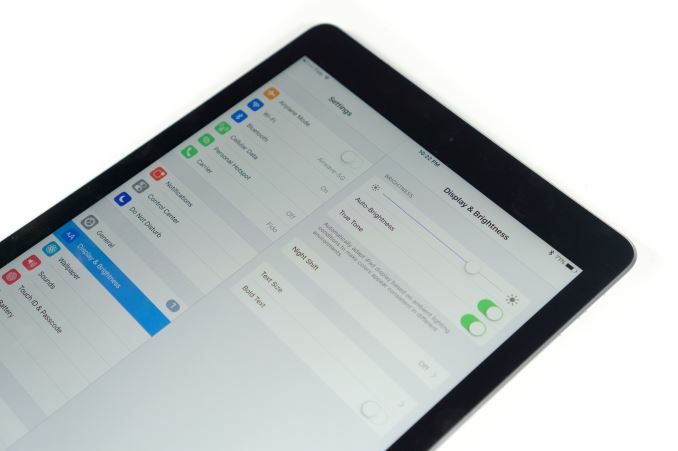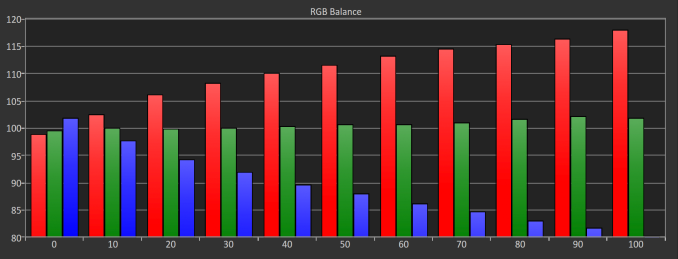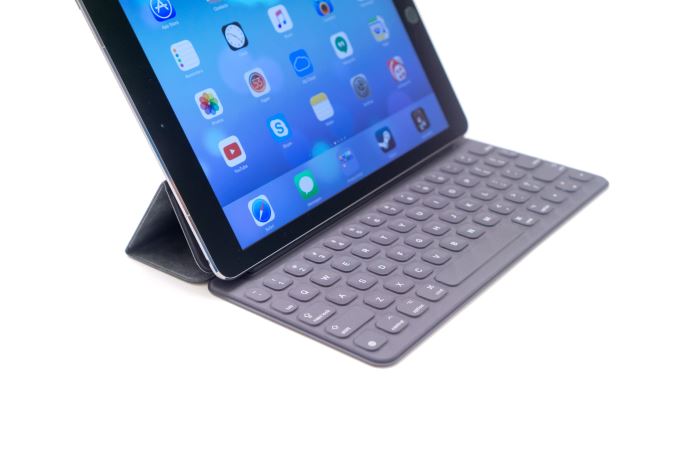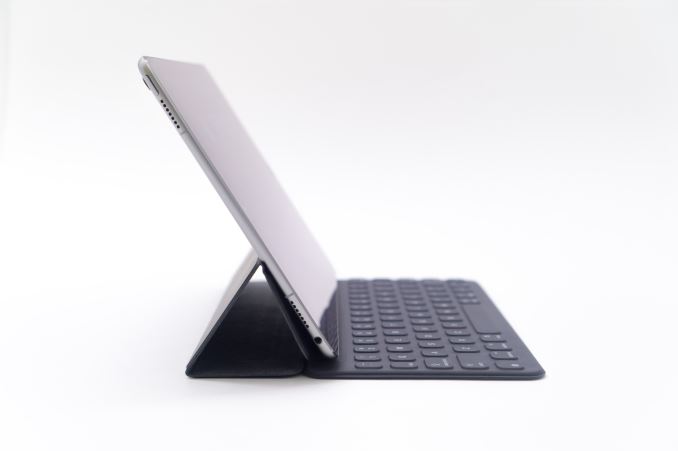The 9.7" iPad Pro Review
by Brandon Chester on June 1, 2016 9:00 AM ESTFinal Words
Late last year Apple’s traditional September event took place, and the company decided to combine their iPhone and iPad launches into one keynote. At that time the iPad Air 2 was almost a year old, but there was no successor announced. I was quite concerned about this at the time, as I thought it could be an indication that Apple was slowing their release schedule in response to the lack of Android devices that competed with the Air 2’s hardware even one year after its release. Fortunately, I was wrong, and the launch of the 9.7” iPad Pro this year brought some interesting changes to both Apple’s 9.7” iPad, as well as the positioning of the iPads as far as having the best specifications goes.
The 9.7” iPad Pro is an upgrade from the iPad Air 2 in essentially every respect. What’s interesting is that in some ways it actually represents an upgrade from the 12.9” iPad Pro. While a quick examination of Apple’s launches would lead you to believe that the 9.7” iPad Pro was launched late, it actually looks like it was launched on schedule, while the 12.9” model was the one that was delayed. This explains the significant gap between the displays and cameras of the two iPad Pro models, with the larger of the two having been planned to launch before Apple began moving any of their products to a wider gamut, and well before a 12MP camera debuted on the iPhone 6s. Because of this, Apple is now in a bit of an awkward situation, as there’s no way for someone to actually buy an iPad with the absolute best specs for every component. It’s worth going over where the smaller iPad Pro differs from the larger model, as well as what changes have been made coming from the iPad Air 2.
The design of the 9.7” iPad Pro is great. When looking at how tablets balance their choice of materials against their mass, thickness, and size, there’s still not really any competition for the iPad. At its core, the 9.7” iPad Pro retains the design of the iPad Air 2, but Apple has brought over the changes from the larger model like the four-speaker audio solution. The inclusion of the 12MP camera brings both a True Tone flash and a camera hump, the latter of which being an unfortunate concession to allow for the significantly improved image quality. The cellular model also adopts a new antenna design, which ditches the old plastic inserts for injected plastic lines much like the iPhone 6 and 6s. I think this is a huge improvement, as the color matching on the plastic inserts was poor to say the least, and they were never aligned quite right with the rest of the chassis.
As far as performance goes, A9X is still the fastest chip that you’ll find in an ARM tablet, even if this isn’t exactly the same A9X that we saw in the larger iPad Pro. On the CPU side, we’re looking at the exact same performance that the larger model offers, which is pretty significant when you consider the $200 price gap between the two. There will obviously be different throttling characteristics due to this smaller iPad having less area to dissipate heat, but in general you can expect the same performance in CPU-bound tasks from both versions of the iPad Pro. As for GPU performance, it's not as high as the 12.9" model, but it's the best you'll get in a tablet of this size.
It’s clear that rear-facing cameras on tablets are here to stay, and for the sake of those who end up viewing the photos taken with them it’s worth putting in a good camera. With the 9.7” iPad Pro, Apple has used the same 12MP camera as the iPhone 6s, and the ISP built into A9X allows for the same feature set including 1080p120 slow mo, UHD recording at 30fps, and Apple’s Live Photos feature. This is one of the best cameras on a smartphone, although not the absolute best due to heavy competition on the Android side. On a tablet it’s by far the best camera you’ll find, as the 8MP sensor used in older iPads was the best camera on a tablet up until this point, and the 12MP camera in the 9.7” iPad Pro improves photo and video quality in every situation.
It’s not hard to conclude that the display on the 9.7” iPad Pro is the best display on any tablet. It honestly seems like other companies aren’t trying very hard here, with Google using highly reflective cover glass and not index-matching their ITO grid, and Samsung not making use of an anti-glare coating like Apple has been using since the iPad Air 2. With the 9.7” iPad Pro Apple has gone even farther by improving their anti-glare coating and boosting brightness to around 500 nits. The combination of these two makes it perfectly usable even with harsh lighting or the sun coming down right on the display, and it’s actually the first time with any device where I haven’t had to adjust my position to block the surrounding light from making the display unreadable.
In addition to the reduced reflections and greater brightness, Apple is also the first to properly adopt a wide color gamut and the first to properly do display adjustments based on the ambient lighting. One can argue that Samsung has done this with their AMOLED displays, but without proper color management it’s absolutely useless and you are forced to just constrain to sRGB. In Apple’s case, they’ve basically brought ColorSync over from OS X, and the rendition of images and videos just works without any thought on the part of the user. Right now there’s basically no content to take advantage of this gamut, but with the advent of UHD Blu-ray and video streaming it’ll be coming soon, and Apple has put the necessary pieces in place to be ready for when it does.
As for True Tone, it’s just one of those great features that you didn’t know you wanted until you were given it. While it obviously takes away the accuracy relative to the sRGB standard, it does a great job of providing relative accuracy based on how your eye adjusts to different lighting conditions. I was initially skeptical of it, but the way it adjusts the display produces a consistently better matched image than the blue-shifted white you get with it turned off. The biggest issue with True Tone is actually the fact that nothing else has it, so you end up transitioning from this nice display that has adjusted itself to your ambient lighting to one that is always blue-shifted and seemingly more so relative to the iPad.
Since this is an iPad Pro, you also need to consider the Apple Pencil and the Smart Keyboard. This becomes more interesting with the smaller iPad because the multitasking situation is very different than the 12.9” model. With the smaller iPad Pro, you generally won’t use a 50/50 split because both apps adopt the compact horizontal size class and you get an iPhone-esque layout. In general, you either use a single app in portrait, or a side pin split in landscape for a messaging app of some sort. This means that you don’t get the experience of running two full-size applications at the same time, which impacts the sort of workflow you can have.
I think the Apple Pencil is still a must-have with the 9.7” iPad Pro. While I always use the larger iPad Pro in landscape, I’ve found myself taking notes on the smaller one with a single app in portrait mode to make it similar to writing on a standard sheet of paper. Unfortunately, this means you can’t have a second app with a book open, or a web browser, but that’s simply a choice you make when taking the portability and usability of the smaller iPad Pro. The actual experience of writing and drawing is just as good in most cases, although there are definitely some apps where you can utilize an entire 12.9” iPad Pro in landscape to have an enormous drawing canvas. Ultimately these things really come down to which size you buy, and in both circumstances I think the Apple Pencil provides a key part of the iPad Pro experience.
The Smart Keyboard is a different story. I actually like the smaller one much better than the larger one. On the 12.9” iPad Pro I’m already pushing the limits of what I’ll carry around all day, and when you stick on the Smart Keyboard the mass of the total package is just way too high for a tablet. With the 9.7” model you have a much lighter keyboard, and so the impact on the total mass of keeping it attached is much lesser. That being said, you end up taking smaller keys to fit within the smaller area, and the case still looks really awkward folded on top of the iPad.
I originally saw concerns about the usability of a smaller keyboard, but I don’t think the 9.7” Smart Keyboard is any worse than the 12.9” version. The condensed keys take some time to get used to, but you do get used to it. For me personally, the Smart Keyboard isn’t something I’d invest in. It’s very flawed in how you set it up, how it integrates with iOS, and how much tangible improvement it actually brings to the typing experience. On top of that, having the Apple Pencil means that I’m rarely typing out giant blocks of text, and even if I am I’ve been using iPads for so long that my touch typing rate is just as fast as what I can do with a keyboard cover. Obviously this isn’t true of everyone, and if you’re going to buy an iPad Pro it’s worth going to a store to try out the keyboard, but if I was buying accessories I would just be leaving the store with a Smart Cover and an Apple Pencil.
After all the specs, there’s the price of the 9.7” iPad Pro. At $599 it does represent a $100 price hike over the iPad Air 2. However, it now starts at 32GB of storage, while the iPad Air 2 started at 16GB. Obviously this doesn’t remedy the price gap entirely, as the $599 iPad Air 2 had 64GB of storage. However, the significant hardware upgrades that Apple has made with this new iPad Pro are enough to make up the difference, and if you move to the 128GB tier the 9.7” iPad Pro is only $50 more than the 128GB iPad Air 2 used to cost. That extra money gets you a significant improvement in processing power, the best display and camera on any tablet, and support for the Smart Keyboard and Apple Pencil, the latter of which being an awesome tool for anyone who does a lot of writing by hand.
Of course, there’s one more consideration to make. Apple sells two iPad Pro models, and the different in size is significant. The 12.9” iPad Pro is not something you can fit in a purse or a small bag, and it’s best to think about its portability as being more similar to a laptop. Choosing between the two models mostly comes down to the size, and you really need to think about what your workflow is before you decide on which one is best for you.
Besides size, there’s one other factor to consider, which is longevity. The 9.7” iPad Pro is arguably more future-proof than the larger model due to its improved display and camera, but Apple keeping the RAM at 2GB is going to restrict how long it can remain performant with future applications and software updates. Apple’s history with iOS products make me fairly confident that it will run into RAM issues long before A9X’s CPU and GPU or the SSD become the bottleneck. Because of that I don’t think the smaller iPad Pro is something that a consumer or a business can invest in and expect to use for four or five years, while the larger model with 4GB of RAM will still run well after all that time. At this point I don’t think there’s any place for 2GB of RAM in a tablet that markets itself as being for professionals, and in that sense I think the 9.7” iPad Pro is more like a successor to the Air 2 than a long-term usable device like the 12.9” model.
In the end, the 9.7” iPad Pro is clearly the best standard-sized tablet on the market. If iOS isn’t something you can manage with then you’ll obviously have to shop elsewhere, but at this point the hardware and software gaps are so incredibly large that you really need to be sure that you can’t use iOS, because you’ll be missing out on a ton of apps and really great hardware. Unlike the larger iPad Pro, I don’t think it’s a tablet that can actually stay performant for five years. It may be kept alive for that long much like the iPad 2 has been, but that’s more like being kept on life support than truly living. It’s unfortunate that right now you can’t buy an iPad with all of Apple’s best specs, with the smaller iPad Pro boasting a better display and camera, and the larger one having a better GPU and more RAM. I think we’ll eventually reach a point where we see parity between the two, although I wouldn’t be surprised if the $200 price gap begins to shrink at the same time. As it stands, the 9.7” iPad Pro is as good as it gets for tablets of this size, and the only thing you can really hold against it is the concern that it may not be as quick as it is now in the future.















144 Comments
View All Comments
digiguy - Friday, June 3, 2016 - link
What do you know? even core I7 has been made fanless in a 12 inch tablet with a new cooling solution, so I don't see why core M could not work well in 10 inches. Battery life will depend on the battery size, in the onda it's smaller than in ipad air 2 for instance, and it lasts around 4 hours, with a bigger one it could last more, but is definitely much more than the 1 hour you speculate about...erple2 - Sunday, June 5, 2016 - link
But then that's the point, isn't it? Throwing a honestly poorly designed 10" tablet as proof that you can get a good tavlet with Core M is not helping your argument. How good is the display? How are the touch apps? How well does the pen work? How heavy is it? How hot does it run? How long does it run on a charge? What about everything else that is tested? Honestly, there has to be a reason why the big players hasn't integrated a more powerful CPU into a small tablet.As a staunchly anti Apple person, I gave to co cede that Apple really does have the best tablet this generation. While the Pixel C comes close, the Pen is very well implemented. Surfaces are fine, but I find that when I want to do real work, I turn to my much more powerful laptop to do that.
melgross - Wednesday, June 1, 2016 - link
Neither Surface Pro display can match the display for this product. First of all those products were reviewed before this one came out, and secondly, they are both sRGB displays, with their resultant smaller color gamut.Also, the iPad Pro, either model beats the least expensive Surface Pro in performance, and that model costs as much, or more than the competing iPad.
I understand that your Microsoft products are second best in a number of ways. Get used to it.
jlabelle2 - Thursday, June 2, 2016 - link
Having a wider color gamut than sRGB is not universally an advantage. Without going into this discussion on how many (little) images are benefiting from that, even in a proper color managed workflow (and iOS seems to be quite good here), sharing and distributing images with wider color space than sRGB is often (most of the time) counterproductive if others 1/ do not have wide gamut screen (the majority), 2/ do not have applications / browser reading the embedded color space (the majority). As such, the interest is honestly quite limited. It does not hurt at all the iPad, on the contrary, but in real life this is not what will make such display stands above other sRGB gamut wide screens.And regarding the Surfaces and DisplayMate, read in details and you will see they are also praised equally :
"The Surface Pro 4 also has the most accurate on-screen colors of any Tablet display that we have ever measured"
"However, Microsoft has also taken an important initial step, with the Surface 3 providing its best Color Accuracy in typical indoor 300 lux ambient"
My point is that many tablets have just excellent screens and that the iPad Pro does not seem to stand in a class of its own at all. But what makes Surfaces screens a real treat for people that value color accuracy is being able to calibrate the screen. That is making all the difference.
Because LCD screen colors evolve unfortunately with time. It would be interesting that Brandon would test and iPad Air 2, today, used since the beginning and how it differs of the original out of the box measurement.
As such, if we are taking only this criteria, for designer or photo / video editor that value utmostly color accuracy, the non calibrating iPad display is a drawback. I mentioned this because making some photo editing on the wedding I shoot, I can clearly see that the iPad Air 2 I have is no match with the Surface Pro 3 I also have, once calibrated.
Meteor2 - Thursday, June 2, 2016 - link
Cor, you're angry.grayson_carr - Thursday, June 2, 2016 - link
You can compare the displays at the link below. Basically, the calibrations are on par out of the box, with the iPad having a slightly better calibrated white point. The iPad has MUCH higher max brightness and a higher color gamut. The Surface Pro 4 has slightly better contrast and like you said, the ability to do your own calibration. Out of the box I would say the iPad Pro has the slight edge with the higher brightness, higher color gamut, and true tone feature. But the Surface Pro 4 display might be better for professionals down the road with the ability to recalibrate it.http://www.anandtech.com/bench/product/1697?vs=157...
nikon133 - Thursday, June 2, 2016 - link
Performance... in what scenarios? Only if there are pro apps to take advantage of that power, does performance have any meaning. Right now, iPad Pro's "power" is only good for rubbing it into others' faces over a cup of coffee. Once these babies are put to use, iPP turns out just faster iPad, but far cry from Pro device. In real life, it is just an iPad that will turn iBook pages faster, do smoother fly-overs in Apple Maps. Have Apple decided to call it iPad Air 3, no-one would know the difference.I'm finding it ironical that, for ecosystem (and fans) insisting on quality and quantity of casual apps in library, suddenly lack of apps in Pro segment is being ignored or played down. One can't do much on it, but look, oooh, it is so fast.
iPad Pro can be twice as fast as i7 Surface... but without tools from Adobe, Corel, Audodesk... even full-blown Office suite... how is it better Pro tablet than any x86 device?
Re pricing. I cannot compare 32GB iPP with 128GB SP. Much as prices go here in NZ - might differ where you are - 128GB 9.7" iPP is NZ$1,329.00, plus NZ$189 for pen. That makes NZ$1,518, compared to $1,439 for 128GB mCore SP4, which comes with pen. Even if we ignore that these are prices from Apple's and MS's web stores and that SP can be found even cheaper in shops, while iPP basically can't... even if we stick to these prices... you are saying that more expensive device with smaller screen, crippled multitasking, no real library of pro software, no easy (or any, in some cases) way to dock it, connect it to multiple desktop screens, wired network, USB devices... is somehow better device just because it cranked out better score in some synthetic benchmarks..?
OK...
Lochheart - Friday, June 3, 2016 - link
Yes, the Surface can run Adobe, Corel, Autodesk... etc...Do you think anyone will buy a Surface when it need to work on Adobe tools ? It will never happen.
Who work on a 12" screen ? My 15" Laptop is already to small... So yes, a Surface can run lot of stuff... but compare to what we have on PC side, it's just a outdated config overhype.
jlabelle2 - Tuesday, June 14, 2016 - link
"Do you think anyone will buy a Surface when it need to work on Adobe tools ? It will never happen."I do. This is why I replaced my iPad (my wife is still using her iPad Air 2 for casual stuff) with a SP3 and gave my desktop to my kids. I am using the SP3 as a tablet in the bed, train, airplane for media consumption and tablet things, I am attaching the keyboard when I want to type things, but I can also develop my RAW files in the train with Capture One Pro (alternative from Adobe Lightroom) or in the bed in tablet mode. And 12" is plenty enough to work on pictures as the screen is high resolution and you can easily pinch to zoom.
Or I can simply dock it and use it with a calibrated 27" monitor / keyboard and mouse. That is THE point of using a Surface. Doing more than an iPad.
"but compare to what we have on PC side"
It IS a PC. Also. It replaces basically the need for a PC for 98% of the people.
mrochester - Wednesday, June 1, 2016 - link
I see you post in a similar vain here as you do on the Verge forums!